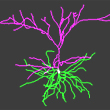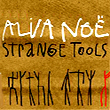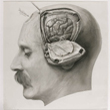Saturday, 22 September 2012
The 1001 Faces of the Neuron
 The kind of diagram used to represent a typical neuron with its specialized extensions (axon and dendrites) can make us forget the unbelievable variety of shapes that these nerve cells can actuslly have. If you don’t believe it, go take a look at the web site NeuroMorpho.Org (click the link below).
The kind of diagram used to represent a typical neuron with its specialized extensions (axon and dendrites) can make us forget the unbelievable variety of shapes that these nerve cells can actuslly have. If you don’t believe it, go take a look at the web site NeuroMorpho.Org (click the link below).
This site contains a database of more than 6600 digitally reconstructed images of neurons and their complex branching structures, and even lets you view them in 3D. This image database was compiled from contributions from over 60 laboratories worldwide that use a variety of methods of staining and neuronal tracing in their experiments. (more…)
From the Simple to the Complex | Comments Closed
Monday, 10 September 2012
Why You Are Not Just Your Brain
 In the introduction to their 1991 book The Embodied Mind, Francisco Varela, Evan Thompson, and Eleanor Rosch noted that as of that writing, the cognitive sciences had little to say about what it means to be human in the concrete situations of everyday life. This criticism was aimed directly at the prevailing paradigm, according to which the human brain worked somewhat like a computer, with input, information processing, symbolic representation, output, and so on.
In the introduction to their 1991 book The Embodied Mind, Francisco Varela, Evan Thompson, and Eleanor Rosch noted that as of that writing, the cognitive sciences had little to say about what it means to be human in the concrete situations of everyday life. This criticism was aimed directly at the prevailing paradigm, according to which the human brain worked somewhat like a computer, with input, information processing, symbolic representation, output, and so on.
In contrast, the approach proposed by Varela and his colleagues, to which they gave the name “enaction”, emphasizes how much our reasoning depends on our bodies and on the environmental context in which they are situated. (more…)
Body Movement and the Brain, The Emergence of Consciousness | Comments Closed
Monday, 3 September 2012
The beginning of modern neurosurgery
 Probably the oldest form of neurosurgery is trepanation, which consisted in drilling a hole in the skull to allow evil spirits to escape from the brain. For example, scientists have found the skull of a young girl who was trepanned with a flint instrument in about 3 500 BCE. What is most remarkable are the scars suggesting that she survived this operation.
Probably the oldest form of neurosurgery is trepanation, which consisted in drilling a hole in the skull to allow evil spirits to escape from the brain. For example, scientists have found the skull of a young girl who was trepanned with a flint instrument in about 3 500 BCE. What is most remarkable are the scars suggesting that she survived this operation.
Modern neurosurgery did not really begin until the late 19th century, when surgeons opened the meninges to operate directly on the brain. But these first years were difficult ones: the survival rate for any surgical procedure that involved opening the skull was only 10%!
Then came American surgeon Harvey Cushing (1869-1939), now regarded as the father of modern neurosurgery. In the early 20th century, he developed a great many new techniques that increased the survival rate for neurosurgery spectacularly, to over 90%! (more…)
From the Simple to the Complex | Comments Closed







